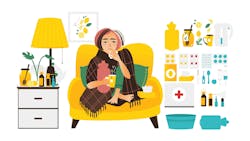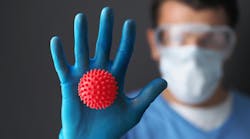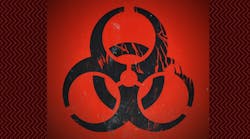Staying ahead of respiratory illness season: Best practices for health-care workers
Respiratory illness season typically peaks in fall and winter. Compared to last year, the Centers for Disease Control and Prevention (CDC) expects this season will have a similar or lower number of combined hospitalizations from COVID-19, influenza (flu), and respiratory syncytial virus (RSV).1 At the time of publication, flu and RSV are reported low nationally. COVID-19 is elevated nationally, but there are signs of decline in many areas.
These viruses take root in the nose, mouth, airway, and/or lungs. Common signs and symptoms with all these illnesses range from fever, cough, runny/stuffy nose, chills, sore throat, and muscle/body aches. Some additional illness-specific symptoms include new loss of taste or smell with COVID-19 and wheezing with RSV. COVID-19 and flu share similar symptoms, which makes testing necessary to differentiate them.
Illness transmission
Each illness spreads differently. COVID-19 is reportedly transmitted through contact with respiratory fluids.2 Someone can be exposed when an infected person coughs or speaks near them. It can also occur by inhaling aerosol particles. These particles can travel up to six feet and may be carried through the air in small droplets on air currents and are at risk of being inhaled.
The flu is reportedly spread by large droplets when a person coughs, talks, or sneezes.3 RSV can be spread through contact with droplets from the nose and throat of infected people when they cough or sneeze, direct contact such as kissing a child’s face, or touching a surface with the virus on it and then touching your face without washing your hands.4
There are similar ways to prevent the spread of these illnesses. Hand hygiene is the single most critical measure in reducing transmitting organisms.5 Frequent hand washing, washing visibly dirty hands, and using hand sanitizer are three best practices for hand hygiene. The CDC also reports that vaccinations are one of the best things you can do to help protect yourself from serious diseases.6
Preventing transmission
There are other ways to prevent transmission to reduce the spread of these illnesses. To reduce the spread of respiratory illnesses, the CDC recommends using source control, such as masks, during high hospital admission rates and community outbreaks. You can alert patients of masking requirements with signs posted at the entrance of your facility, messaging on your website, or a message in appointment reminders. Postpone nonurgent treatment for those with suspected or confirmed illnesses.
Personal protective equipment (PPE) should be available and used. Use is determined based on the risk of exposure to blood, body fluids, saliva, and respiratory illness. PPE is to be provided and maintained by the employer.7 The different types of PPE are gowns, gloves, masks, eye protection, and N-95 respirators, which should be considered for use during aerosol-generating procedures.
Common procedures that create aerosols in medical facilities are intubation, tracheotomy, CPR, bronchoscopy, and sputum induction. Dental equipment known to create aerosols are ultrasonic scalers, high-speed handpieces, air/water syringe, air polishing, and air abrasion. Fit testing is required for all N-95s prior to their first use and annually thereafter when they’re used.8
Employee guidance
If a health-care professional (HCP) has a respiratory illness, they should follow the CDC’s guidance on when to return to work.9
1. COVID-19: a) HCP with mild to moderate illness who are not moderately to severely immunocompromised could return to work after the following criteria have been met: at least seven days have passed since symptoms first appeared if a negative viral test* is obtained within 48 hours prior to returning to work, or 10 days if testing is not performed or if there’s a positive test at day five, six, or seven; at least 24 hours have passed since last fever without the use of fever-reducing medications; and symptoms such as cough and shortness of breath improve.
b) HCP who were asymptomatic throughout their infection and are not moderately to severely immunocompromised could return to work after the following criteria have been met: at least seven days have passed since the date of their first positive viral test if a negative viral test* is obtained within 48 hours prior to returning to work, or 10 days if testing is not performed or if a positive test at day five, six, or seven.
c) HCP with severe to critical illness who are not moderately to severely immunocompromised could return to work after the following criteria have been met: at least 10 days and up to 20 days have passed since symptoms first appeared; at least 24 hours have passed since last fever without the use of fever-reducing medications; and symptoms such as cough and shortness of breath improve.
2. Flu: Employees with confirmed flu who have a fever should be fever-free for 24 hours without the use of fever-reducing medicine.10 Employees with suspected or confirmed flu without a fever should stay home for at least four to five days after symptoms begin.
3. RSV: Employees with RSV are contagious for three to eight days. Employees can return to work when fever-free for at least 24 hours and symptoms improve.11
By implementing these measures and adhering to CDC guidelines, we can ensure a safe and healthy environment for patients and staff.
*Either a NAAT (molecular) or antigen test may be used. If using an antigen test, HCP should have a negative test obtained on day five and again 48 hours later.
Editor's note: This article appeared in the November/December 2024 print edition of RDH magazine. Dental hygienists in North America are eligible for a complimentary print subscription. Sign up here.
References
1. Respiratory illnesses data channel. Centers for Disease Control and Prevention. Accessed September 20, 2024. https://www.cdc.gov/respiratory-viruses/data/index.html
2. Indoor air and coronavirus (COVID-19). United States Environmental Protection Agency. Accessed September 20, 2024. https://www.epa.gov/indoor-air-quality-iaq/indoor-air-and-coronavirus-covid-19
3. How flu spreads. Centers for Disease Control and Prevention. Accessed September 20, 2024. https://www.cdc.gov/flu/about/disease/spread.htm
4. Respiratory syncytial virus (RSV) infection. New York State Health Department. Accessed September 20, 2024. https://www.health.ny.gov/diseases/communicable/respiratory_syncytial_virus/
5. Hand hygiene: What you should (and may not) know. University of Iowa Healthcare. Accessed September 20, 2024. https://medcom.uiowa.edu/brennan/?p=2224#:~:text=Hand%20hygiene
6. Vaccines by disease. Centers for Disease Control and Prevention. Accessed September 20, 2024. https://www.cdc.gov/vaccines/by-disease/index.html
7. Handout #2. Employers must provide and pay for PPE. Occupational Safety and Health Administration. Accessed September 20, 2024. https://www.osha.gov/sites/default/files/Handout_2_Employers_Must_Provide_and_Pay_for_PPE.pdf
8. Fries E, Zhuang Z. Frequency of respirator fit testing. Centers for Disease Control and Prevention. Accessed September 20, 2024. https://blogs.cdc.gov/niosh-science-blog/2008/04/21/respirator/
9. Interim guidance for managing healthcare personnel with SARS-CoV-2 infection or exposure to SARS-CoV-2. Centers for Disease Control and Prevention. Accessed September 20, 2024. https://www.cdc.gov/covid/hcp/infection-control/guidance-risk-assesment-hcp.html
10. Stay home when sick. Centers for Disease Control and Prevention. Accessed September 20, 2024. https://archive.cdc.gov/#/details?q=staty%20home%20when%20sick&start=0&rows=10&url=https://www.cdc.gov/coronavirus/2019-ncov/downloads/people-with-idd/CDC_RTI_StayHome_SocialStory_508c.pdf
11. How RSV spreads. Centers for Disease Control and Prevention. Accessed September 20, 2024. https://www.cdc.gov/rsv/causes/index.html
About the Author
Renee Russell, BHS, RDH, CDIPC
Renee has been a Total Medical Compliance consultant since 2016, specializing in OSHA, HIPAA, and infection control since 2008. With more than 30 years in dental care, she’s served as a dental assistant, RDH, and compliance officer. Renee earned her BHS from the Medical University of South Carolina and was named South Carolina's Dental Hygienist of the Year in 2010. She is CDIPC-certified, a speaker, and a Hu-Friedy key opinion leader.


